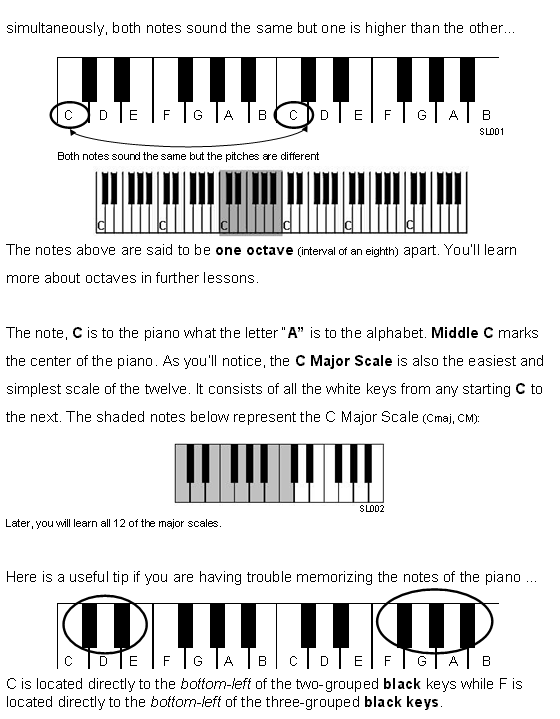Sunday 14 December 2014
Friday 12 December 2014
welcome to Piano By Ear
Playing piano without years of lessons
and sheet music is now easier than ever before!
"Discover The Secrets to Quickly & Easily Playing All Your Favorite Songs On The Piano By Ear...
...Using The Same Exact System Thousands Of Musicians Are Using To Play Anything They Hear On The Radio In Just A Few Minutes!"
I personally think there's a huge problem out there for musicians who want to play piano (or any instrument, for that matter) by ear.
...And I'm guessing that you're reading this page because you, too, have faced the same problems that I'll talk about soon.
Now... It's not that there isn't help out there...
There's just not much help for musicians who want to play outside of traditional "sight reading" or classical methods you've probably come across.
I'm talking about help for "ear" musicians.
Musicians who want to:
|
|
Within months of starting Home Piano Lesson International, musicians from all around the world were e-mailing me request after request to teach them this song... and that song. This chord and that chord --- chord changes, progressions, hymns, music theory, ear-training, gospel music, jazz standards, blues, licks & tricks, ~~~~~~ (the list goes on and on).
So...
...If any of this sounds familiar, the good news is that you're not alone.
If you're like most of my students, you're struggling to pick out melodies, chords, chord progressions, and patterns in songs. Heck, if you're just getting started, you probably don't even know what chords and progressions are!
If you've gone further and started to teach yourself, perhaps you're at a roadblock and really trying to put all this stuff together.
Maybe you're reading self-help books and have bought every training manual or "how-to" video --- or have even taken personal music lessons --- but have been disappointed with the results.
Learning piano is not an overnight thing. It requires commitment, drive, and discipline. Even pros practice daily and are constantly learning new things.
Great musicians never think in terms of a "destination." It's always a "journey."
There's always new things to learn.
New genres. New techniques and styles. Unfamiliar theory and alternative ways to approach music. Other things to explore. And just simply improving upon what you already know.
So with that said... if you think I'm just going to teach you some magical chords and you're going to play every song you've ever wanted to by tomorrow, then stop reading this page. I'd hate to waste your time.
But if you're willing to put in some time and practice, I can guarantee that in very little time (compared to years and years of training, lessons, and school), you'll be playing the piano by ear and even picking up songs on the radio.
"Wait!"
I hear you saying under your breath.
Simply put. Because my methods are proven and tested. Not fluff... not theories... not "would-be" or "could-be" methods but techniques that have helped literally hundreds of musicians by ear.
FIRST LESSON
Learning the notes of the piano (01)

watch or download these videos
"Learning piano doesn't have to be hard. Learn the shortcuts and tricks to playing piano quickly and easily."
Here's an example of a few shortcuts that'll save you lots of time. You may or may not already know them. Of course, you'll want to read the rest of this page to find out how to get all the secrets... but for now, pay close attention to what I'm sharing here.
In my "advice box" above, you've already learned how to use chordal system to harmonize a song or a melody. Now I want to show you an easy technique on how to play any melody or chord progression in all 12 keys!
You should definitely print these "easy formulas" out. You'll use them a lot in the beginning. This is just one time-saving strategy that you can use to start playing piano by ear in no time.
...Just to think...
 With private lessons, you probably wouldn't get passed "seventh" or "ninth" chords after a year or so and thousands of cedis in fees. That is, if you can find a teacher who specializes in the style of music you want to play by ear. That's the tough part. With private lessons, you probably wouldn't get passed "seventh" or "ninth" chords after a year or so and thousands of cedis in fees. That is, if you can find a teacher who specializes in the style of music you want to play by ear. That's the tough part.
Even at gh60 an hour (which is cheap), weekly lessons would cost you Gh3,560 per year. After the second year, you would have paid over ghc3,000.00 bucks! Most people take years of lessons and only a handful of them continue on to their desired levels. Others teach themselves at their own paces and thousands of dollars cheaper.
Here’s a Nice Sounding Chord Movement You Can Use Immediately
In this post, I want to share a cool way to play a 1-chord.
What do I mean by “1-chord?”
It’s simple. Every major key has chords associated with each tone of its scale. For example, the C major’s scale is:
By simply numbering the scale, you get:
C = 1
D = 2 E = 3 F = 4 G = 5 A = 6 B = 7
I could go on to talk about how to form the chords on each tone of the scale, but there are plenty of posts here about that.
So the 1-chord simply falls on the first tone of the scale.
Normally, the 1-chord would be major. In this case, some type of C major chord:
But here’s a little trick you’ll find pros doing.
Instead of going straight to a C major chord, play the major chord of the 3rd tone of the scale over C bass.
In our case, that would be E major over C bass.
This turns the chord into a C augmented major 7 (or Cmaj7 #5). The only thing we’re doing differently is doubling up on the “E” (playing octaves, which means to play the lower and upper E).
Of course, you won’t stay on this chord because it doesn’t quite give you the feeling and resolution of a typical 1-chord. So you’ll move the two middle notes (“G#” and “B”) up one-half step to “A” and “C” respectively:
This turns the chord into a C major 6 or C major (add 6) and sounds really good coming from the previous augmented chord.
So how do you apply this in any key?
1) Press the T1-bass in your left hand.
2) Locate the 3rd tone of the scale and play its major chord on your right hand.
3) Make sure to double up on the lowest note of the right hand by placing it on top as the highest note as well. (E major = E + G# + B + E)
4) Assuming you’ve doubled up on the first note, take the two middle notes and raise them a half-step each to resolve to the Major 6 chord. Keep the bass note the same.
This is a video on Major chords,Minor Chords,minor sevenths,diminished,augmented
MORE VIDEOS ON THIS SITE!
Im glad you have learned few things within just a little time spent on this site,should you want to learn more ,
then call Steve on
0542992386 / 0248727936 or click here
JOIN OUR SKYPE PIANO LESSON,ONLY ON FRIDAYS
KYPE NAME: Steve Chord
PLEASE CLICK HERE FOR DETAILS OR CALL 0248727936 |
Subscribe to:
Posts (Atom)






